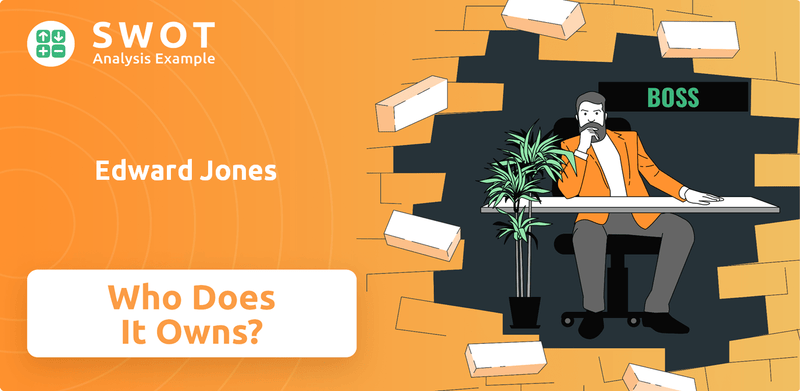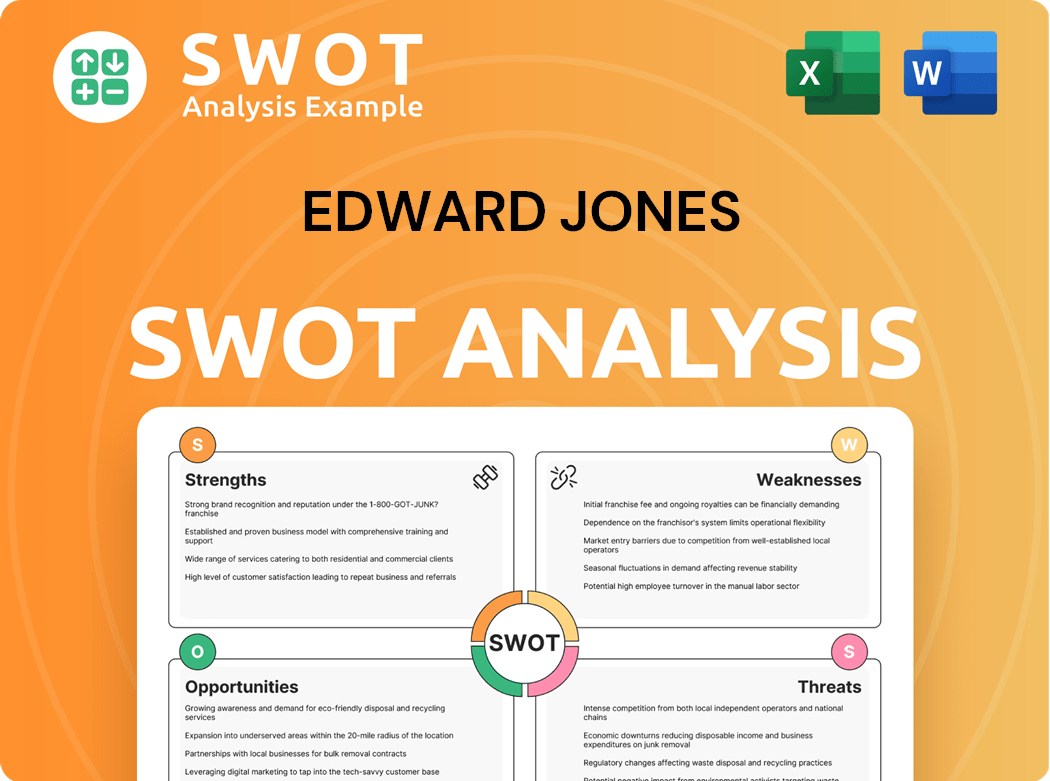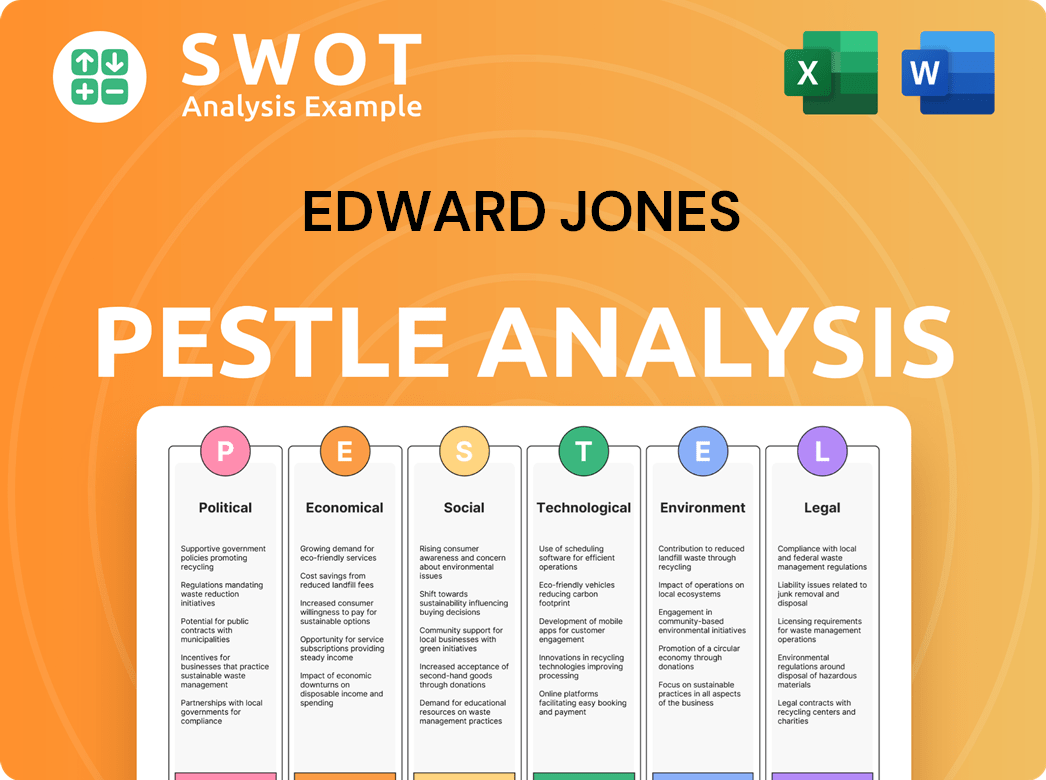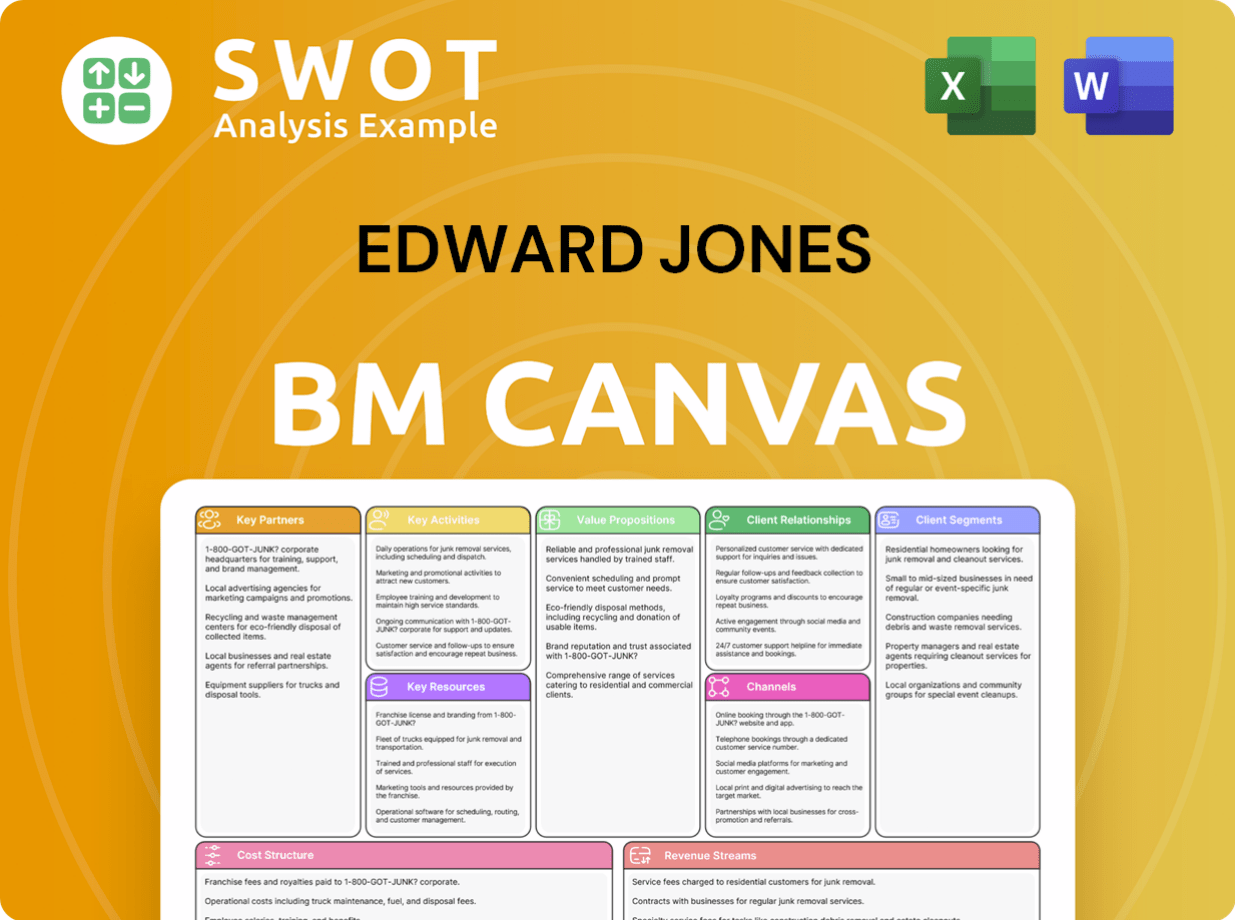Edward Jones Bundle
Who Really Owns Edward Jones?
Unraveling the ownership of a financial powerhouse like Edward Jones is key to understanding its strategic moves and long-term vision. Founded in 1922, Edward Jones Company has grown into a financial services giant, but its unique structure sets it apart. Discover how its ownership model shapes its approach to clients and the financial markets.

Edward Jones' Edward Jones SWOT Analysis reveals insights into its competitive strengths, and understanding its ownership is crucial for grasping its market position. The firm's private ownership model, a limited partnership, significantly influences its governance and strategic decisions. This structure impacts everything from the Edward Jones financial advisor experience to the firm's overall long-term strategy, making it a fascinating case study in the financial services industry. Exploring the Edward Jones history, including its founders and key Edward Jones executives, provides a deeper understanding of its current trajectory.
Who Founded Edward Jones?
The story of the Edward Jones Company begins with its founder, Edward D. Jones, who established the firm in 1922. His vision was to create a financial services company centered on individual investors, emphasizing personal relationships and long-term investment strategies. This approach set the foundation for what would become a significant player in the financial industry.
Initially, the ownership structure of the Edward Jones Company was straightforward, reflecting the founder's direct control. Edward D. Jones, a former bond salesman, started the firm as a sole proprietorship. This meant he held 100% of the equity and made all the key decisions, setting the tone for the company's culture and operations from the very beginning.
As the firm grew, Edward D. Jones brought his son, Edward D. Jones Jr., into the business. While the specific equity splits from the early days are not publicly available due to the firm's private nature, the transition of leadership and ownership within the family was a crucial early development. This ensured the preservation of the initial strategic direction and values as the company expanded.
The early years of the Edward Jones Company were marked by family leadership and a focus on building a strong client base. The firm's growth was also supported by the dedication of its early financial advisors, who played a key role in fostering the company's unique culture. The company's commitment to a relationship-based advisory business was established early on.
- Edward D. Jones founded the firm in 1922.
- The initial ownership was a sole proprietorship.
- Edward D. Jones Jr. joined the firm and played a key role in its expansion.
- Early agreements focused on establishing the operational framework and client service model.
Edward Jones SWOT Analysis
- Complete SWOT Breakdown
- Fully Customizable
- Editable in Excel & Word
- Professional Formatting
- Investor-Ready Format

How Has Edward Jones’s Ownership Changed Over Time?
The evolution of the Edward Jones Company's ownership reflects a strategic shift from its beginnings as a sole proprietorship. A critical turning point was the adoption of a partnership model. This change allowed key employees, including Edward Jones financial advisors, to become owners. This transition cultivated a strong sense of shared responsibility and aligned the firm's objectives with the long-term interests of its partners. This shift from a family-owned business to a broader partnership was crucial for scaling the business while preserving its unique culture and values. The Revenue Streams & Business Model of Edward Jones highlights how this ownership structure supports its operational strategies.
Edward Jones operates as a limited partnership, with The Jones Financial Companies, L.L.L.P. serving as its general partner. This entity is owned by current and former employees and financial advisors. This structure means that a significant portion of the firm's ownership is held by those actively involved in its operations, setting it apart from publicly traded firms. In early 2024, the firm reported record net revenue of $16.2 billion for 2023, with client assets under care reaching $1.9 trillion. The firm also distributed a record $2.0 billion in profit sharing to its employees in 2023. These figures demonstrate the success of the firm under its current ownership model, which incentivizes performance and long-term commitment among its partners. The limited partnership model means there are no external public shareholders in the traditional sense.
Edward Jones's ownership model is a limited partnership, primarily owned by its employees and financial advisors.
- This structure fosters a strong alignment between the firm's interests and those of its partners.
- The firm's financial performance, including record revenue and profit sharing in 2023, underscores the success of this ownership model.
- There are no external public shareholders, which distinguishes it from publicly traded companies.
- The leadership team and Edward Jones executives are key stakeholders.
Edward Jones PESTLE Analysis
- Covers All 6 PESTLE Categories
- No Research Needed – Save Hours of Work
- Built by Experts, Trusted by Consultants
- Instant Download, Ready to Use
- 100% Editable, Fully Customizable

Who Sits on Edward Jones’s Board?
The governance of the Edward Jones Company is managed by The Jones Financial Companies, L.L.L.P., acting as the general partner for Edward D. Jones & Co., L.P. The board of directors for The Jones Financial Companies, L.L.L.P. comprises current and former senior leaders and partners from within the firm. This structure ensures that the board possesses extensive operational expertise and a vested interest in the long-term prosperity of the company. The board's composition reflects the firm's partnership model, with members typically drawn from various divisions and leadership roles within Edward Jones. While specific individual board members and their exact ownership stakes are not publicly disclosed, this internal structure supports strategic independence.
The board's composition supports the company's focus on long-term strategy and client service. The internal control mechanism allows the firm to maintain its strategic independence and focus on its long-term vision without the pressures often associated with external shareholder activism or short-term market demands. This governance model aligns decision-making with the interests of its internal stakeholders, fostering stability and a consistent approach to client service and business development. The firm's private partnership structure inherently mitigates external pressures, which is a key aspect of understanding the Growth Strategy of Edward Jones.
| Aspect | Details | Significance |
|---|---|---|
| Governance Structure | The Jones Financial Companies, L.L.L.P. as general partner. | Ensures internal control and strategic focus. |
| Board Composition | Composed of current and former senior leaders and partners. | Provides deep operational knowledge and vested interest. |
| Voting Power | Concentrated among general partners. | Maintains strategic independence and long-term vision. |
Understanding the Edward Jones ownership structure reveals that the company operates under a partnership model, which significantly impacts its governance and strategic direction. This structure allows the firm to prioritize long-term goals and client relationships over short-term market pressures. The board's focus and the voting structure within Edward Jones are designed to support stability and a consistent approach to client service and business development. The absence of external shareholder activism is a key characteristic of this structure.
Edward Jones operates under a partnership model, which impacts its governance and strategic direction.
- The board is comprised of current and former senior leaders and partners.
- Voting power is concentrated among general partners.
- The structure supports long-term goals and client relationships.
- There are no publicly reported proxy battles or activist investor campaigns.
Edward Jones Business Model Canvas
- Complete 9-Block Business Model Canvas
- Effortlessly Communicate Your Business Strategy
- Investor-Ready BMC Format
- 100% Editable and Customizable
- Clear and Structured Layout

What Recent Changes Have Shaped Edward Jones’s Ownership Landscape?
In the past few years, the ownership structure of the Edward Jones Company has remained consistent, emphasizing its partnership model. This model distinguishes it from many financial services firms that have experienced consolidation and increased institutional ownership. As of early 2024, the company reported continued growth, with client assets under care reaching $1.9 trillion. This financial performance further solidifies the success of its internal ownership structure. The firm's commitment to its partnership model means that significant share buybacks or secondary offerings in the traditional public market sense are not applicable. Instead, changes in Edward Jones Ownership are more likely to occur through internal partner transitions and the admission of new partners.
Recent trends within Edward Jones focus on strategic investments in technology and advisor support. This includes a $1 billion investment in technology and digital initiatives over the next five years. The firm consistently emphasizes its dedication to its partnership structure as a core element of its identity and long-term strategy. This approach contrasts with industry trends, as Edward Jones is largely insulated from external pressures. The Marketing Strategy of Edward Jones highlights the firm's focus on organic growth and serving individual investors within its established ownership framework.
| Metric | Value | Year |
|---|---|---|
| Client Assets Under Care | $1.9 trillion | 2024 |
| Record Net Revenue | $16.2 billion | 2023 |
| Technology Investment | $1 billion (over 5 years) | Ongoing |
The Edward Jones Company continues to prioritize its internal partnership model, focusing on organic growth and supporting its financial advisors. This strategy has allowed it to maintain its unique ownership structure within the evolving financial services landscape. The company's focus remains on attracting and retaining talented financial advisors and serving individual investors.
Edward Jones operates under a partnership model, with ownership primarily held by its partners. This structure fosters a long-term perspective. The firm is not publicly traded, distinguishing it from many competitors.
The firm's leadership team is crucial to its strategic direction and is composed of internal partners. While specific executive roles change, the leadership maintains the firm's focus. This model supports the company's commitment to its long-term strategy.
The firm's financial performance, including assets under care and revenue, demonstrates the success of its ownership model. The company's financial health reflects the stability and focus of its internal ownership.
Edward Jones is expected to maintain its partnership model, with continued investments in technology and advisor support. The firm's focus on organic growth and client service will likely remain central to its strategy.
Edward Jones Porter's Five Forces Analysis
- Covers All 5 Competitive Forces in Detail
- Structured for Consultants, Students, and Founders
- 100% Editable in Microsoft Word & Excel
- Instant Digital Download – Use Immediately
- Compatible with Mac & PC – Fully Unlocked

Related Blogs
- What are Mission Vision & Core Values of Edward Jones Company?
- What is Competitive Landscape of Edward Jones Company?
- What is Growth Strategy and Future Prospects of Edward Jones Company?
- How Does Edward Jones Company Work?
- What is Sales and Marketing Strategy of Edward Jones Company?
- What is Brief History of Edward Jones Company?
- What is Customer Demographics and Target Market of Edward Jones Company?
Disclaimer
All information, articles, and product details provided on this website are for general informational and educational purposes only. We do not claim any ownership over, nor do we intend to infringe upon, any trademarks, copyrights, logos, brand names, or other intellectual property mentioned or depicted on this site. Such intellectual property remains the property of its respective owners, and any references here are made solely for identification or informational purposes, without implying any affiliation, endorsement, or partnership.
We make no representations or warranties, express or implied, regarding the accuracy, completeness, or suitability of any content or products presented. Nothing on this website should be construed as legal, tax, investment, financial, medical, or other professional advice. In addition, no part of this site—including articles or product references—constitutes a solicitation, recommendation, endorsement, advertisement, or offer to buy or sell any securities, franchises, or other financial instruments, particularly in jurisdictions where such activity would be unlawful.
All content is of a general nature and may not address the specific circumstances of any individual or entity. It is not a substitute for professional advice or services. Any actions you take based on the information provided here are strictly at your own risk. You accept full responsibility for any decisions or outcomes arising from your use of this website and agree to release us from any liability in connection with your use of, or reliance upon, the content or products found herein.